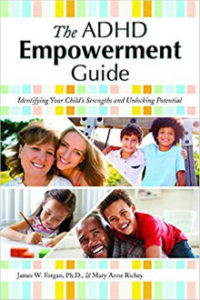ADHD Challenges: Focus on Strengths & Potential
The ADHD Empowerment Guide: Identifying Your Child’s Strengths and Unlocking Potential
By James W. Forgan, PhD, and Mary Anne Richey
(Prufrock Press, 2019 – Learn more)

Since starting my new website, Thinking Through ADHD, I have been involved with tons of research dealing with the subject. Most of what I find addresses the problems and comorbidities that are encountered.
When I saw The ADHD Empowerment Guide that talked about a child’s strengths and potential, I felt that I had to grab it.
The first chapter is entitled “Success with ADHD,” and one of the first things that caught my eye was this thought:
“When your child understands her strengths and knows how to use them to her advantage or to bypass weaknesses, your child feels more confident and successful.”(p.18)

The authors suggest finding these strengths and weaknesses via multiple intelligence profiles and a Keys to Success Survey.
Understanding multiple intelligences
There are many ways to help our children/teens unlock their potential, but it all starts by examining a theory of Howard Gardner. This theory is called Multiple Intelligences because Gardner believed that everyone is more than just one IQ score. We all have a variety of talents and traits.
But multiple intelligence profiles do more than highlight gifts; they can also shine a light on weaknesses. In chapter 3 Forgan and Richey explain each kind of intelligence with examples and give activities to strengthen these areas if they are found to be weak.
Chapter 4 explains the Keys to Success, mentioned above as one of the tools we can use to figure out our students’ gifts and weaknesses. The authors describe and explain aspects of behavior and thought that can limit or assist us all to reach to our goals successfully. Many have to do with executive functioning skills.
The authors also explore eleven traits associated with ADHD, giving background information, strategies for strengthening them, and resources that could help, such as stories to read and book suggestions for adults. Also included for each are possible careers and examples of people who have overcome the difficulty.
Treatment and resources
Medication and questions about its use is first in the lineup of Treatments for Success, which is the focus of chapter 5. Also included are some of the recent additions to the pharmaceutical market. Behavioral and therapeutic treatments are discussed along with neurofeedback, mindfulness and food-based treatments. This chapter ends with information on ADHD coaching and video coaching.
The remaining chapters focus on Understanding Your Rights in chapter 6, Finding the Right Fit (in a school) in chapter 7, and The Success Plan, which shows you how to put it all together, in Chapter 8. Forgan and Richey close with a load of references as well as a PDF link for their Multiple Intelligences Profile and Keys to Success survey.
The ADHD Empowerment Guide is a fabulous find for anyone who deals with children or teens with ADHD, but I can think of many more students that these ideas would help outside the ADHD diagnosis. I love this more positive approach!
Joanne Bell is a middle school teacher at St. Joseph Elementary School in Cottleville, Missouri. She currently teaches social studies to sixth and seventh graders and is working on a blog about ADHD, Thinking Through ADHD.





























I am one of the authors of The ADHD Empowerment Guide – Identifying Your Child’s Strengths and Unlocking Potential reviewed by Joanne Bell. We would be happy to write a guest post about a topic of interest, like motivation, any executive functioning skills, or ADHD in general.